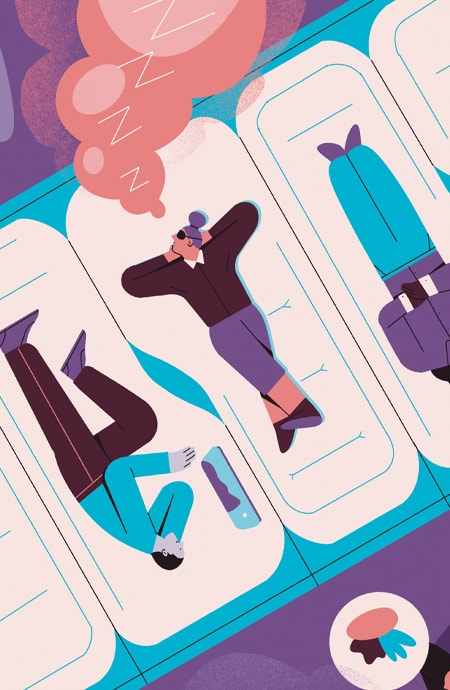What Will Business Class Look Like Over the Next Two Decades?
As it continues to evolve, incorporating new comforts and luxuries, the future of business class can be seen in the aircraft of today
by John Walton
November 2, 2022

Illustration by Michał Bednarski
What’s the future of business class over the next 20 years? Ultra-private pods, lined with sumptuous fabrics and designed to emulate a private yacht or luxury automobile. Flying chaises longues, allowing passengers to cocoon themselves away from the world for a few hours in the sky. For couples, intimate double beds that really feel like double beds, with hotel-quality linens and a freshly made cup of cocoa or a top-shelf nightcap. You’re served the very best wines, alongside à la carte dining that rivals anything on the ground, with exquisite flavors of the world combined with signature dishes from the home country of the airline you’re flying: a Japanese kaiseki tasting menu, for example, or a Finnish kahvikutsut coffee-and-cake trolley.
You’re invisibly connected with technology that sends a flight attendant with a cup of loose-leaf tea or espresso the moment your smartwatch senses that you wake up. As international first-class travel continues its long sunset, the future of premium travel will evolve from what we now know as business class, a category that is more than 40 years old but still at the forefront of innovation.
To get to this incredible future, airlines, seat-makers, airplane manufacturers and an army of designers will build on the basic structures that we see in many places today. The look and feel will certainly change, but the supporting structure of this highly regulated and strongly engineered industry is already visible—if you know where to look.
The space designers are working in has largely been defined
Let’s start with the bigger picture: the airplanes you’ll fly in. For the next couple of decades at least—which is about as far out as we can look in aviation, given there are no significant new models of wide-body or narrow-body aircraft announced—you’ll do almost all your flying on certain types of airplanes, which are split between larger twin-aisle wide-bodies and smaller single-aisle narrow-bodies, almost entirely from Boeing or Airbus.
On the Boeing side, the wide-bodies are the smaller 787 Dreamliner and the larger 777, including the forthcoming stretched 777X. On the Airbus side, there’s the larger A350 and the smaller A330neo, with the remaining A380 superjumbo fleet sunsetted by most of the airlines that use it, but around for a good decade or more.
In terms of narrow-bodies, you’ll mainly be flying on the Boeing 737 (including the 737 Max) and the Airbus A320 family (including the stretched A321neo). Keep an eye out for the new long-range Airbus A321LR and soon-to-be-delivered extra-long-range A321XLR, which can fly up to ten hours. These will enable new routes to and from secondary airports, and allow airlines to schedule year-round flights that would have been seasonal.
On long-haul flights, wide-bodies will by and large offer four seats in each row in business class, with direct aisle access for every passenger. On narrow-body long-haul flights on the A321LR and A321XLR, the future will have two seats per row, one on either side of the aisle, but it may take five to ten years to get to that, especially as the current generation of older seats without direct aisle access has yet to be replaced in any widespread way. On shorter flights with narrow-bodies, you’ll see a new generation of recliner seats, like domestic first class within the U.S., or on premium airlines one of the new recliner-plus seats that offer more space and extra privacy.
But let’s head back to long-haul, which is where the very best of the new seats—often rivaling today’s first class—will be found. Here, you’ll typically be flying on one of two layouts: herringbone or stagger.

Illustration by Michał Bednarski
Herringbone angles toward or away from the aisle
Herringbone seats date back to the mid 1990s in first class and early 2000s in business. They often feel like sleeping pods, and offer direct aisle access to every passenger, since their angles mean that either the head or foot of each pod is at the aisle. Think of it like streets that have parking on an angle rather than parallel parking.
Initially, herringbones in business class were inward-facing—in other words, every seat faced towards the aisle. Outward-facing herringbones, where every seat faced away from the aisle (either toward the window or the middle of the aircraft) were developed in the late 2000s, taking over the market for much of the last decade.
Like every kind of seat, there are pros and cons with herringbones. Modern herringbones overlap slightly, with the footwell in bed mode stacked underneath the side table of the passenger in front. This cubby space can feel a little cramped, especially for taller passengers. Sometimes the arrangement of the seats makes it difficult to look out the window, whether that’s because you’re facing away from it or because the seat structure, reading light or storage space is blocking your view. But they’re popular with a lot of airlines—and passengers—and for good reason.
Today, we’re already seeing hybrid herringbone layouts, with window seats and aisle seats. In many ways this is the best of all worlds. Win-dow-seat passengers can gaze outward, while center-seat passengers have their heads together to chat (some designs even convert to what’s almost a double bed). Expect more of these hybrids over the next few years, since they add a lot of benefits for premium leisure passengers, whom airlines expect to make up more of their business-class market.
Staggered seats alternate next to and away from the aisle
Staggered seats that offer direct aisle access for every passenger arrived in the mid 2000s. Each seat goes fully flat. Half are directly next to the aisle, and half are separated by a small gangway ahead of the passenger behind them.
The stagger pattern means that airlines have a choice when arranging the seats in the center section. The first option is to make every seat separate from every other by a side table/footwell. Think of this as the “singleton” option, compared to the “honeymoon/divorce” option where the airline can put two middle seats next to each other away from the aisle (that’s “honeymoon”) and then the seats ahead of them next to the aisle separated by two side tables (that’s “divorce”).
Honeymoon seats are fantastic for couples traveling together, as they often come with center sidewalls that retract to create a double bed from about the knees up. They’re also useful when traveling with colleagues, since you can benefit from the opportunity to have discussions next to each other—but leave the center sidewall all the way up for privacy.

Illustration by Michał Bednarski
In terms of disadvantages, sometimes the foot-wells can feel a bit cramped, but the big one is the “good seats, bad seats” aspect. If the seats that are separated from the aisle sound more private than the ones next to it, you’re not wrong. Aisle-seat passengers are more likely to be disturbed by people walking past and bumping into them. Some airlines and seatmakers are mitigating this by installing doors to block passengers from the aisle.
Narrow-bodies are a key niche market…
A big part of the future of business-class travel will actually be small—smaller airplanes, that is, and particularly the longer-range versions of the Airbus A321neo. These planes have additional fuel tanks and other improvements allowing them to fly up to ten hours. That means they need topnotch business-class seats with all the bells and whistles of much bigger planes. But that’s a challenge given the shape of their cabins, which stretch a full three economy seats on either side of the aisle—more than any equivalent wide-body. The answer looks likely to be herringbone seats, but angled at almost 45 degrees, up from around 25 degrees on bigger planes. The big question is whether passengers prefer inward-facing seats, like on JetBlue’s Mint business class, or outward-facing seats, like some other seatmakers are proposing.
…and more innovations come elsewhere
You can expect more innovation like the new Finnair sofa seat, where instead of reclining the cushioned shell allows passengers to take any comfortable position they want. A few airlines may continue to combine staggers and herringbones to create seats that look like forward-facing seats but act like herringbones. But these will be, by and large, in the minority.
Do business-class seats need privacy doors to turn them into mini-suites, as in first class? That’s one of the big questions that will be decided over the next decade, whether around the smaller half-height doors we see in today’s business or the higher doors in some first classes. The smart money is on doors for the near term, because privacy and space are some of the biggest luxuries you can get, although there are certainly some layouts—like the hybrid herringbones, or the 45-degree-angled outward-facing herringbones—that are extremely private without them.
Part of the question around doors is about weight and complexity: They’re heavy and need maintenance, and many of the early ones are clunky. But with new innovations such as stretching privacy dividers, curtains or fan-style options, it’s clear that the discussion will continue for some time.
As first class disappears, we’re also likely to see the growth of business-plus seats in the front row of the cabin, where there is often more space. This means that airlines can add options like a bigger bed, massive wall-sized television, sofa, partner dining space, personal champagne bar, individual coat closet and more. Some of this will appear in various new generations of business class, as well. But wherever you’re flying, business class will be more luxurious, spacious and comfortable than ever before.



